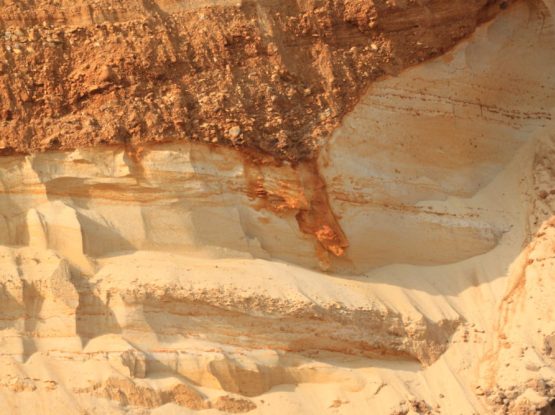Geology

There are 16 SSSIs in Suffolk & Essex Coast & Heaths National Landscape that are identified for their geological features, including three which are designated for both geological and biological value - see our Designated Sites.
The Suffolk & Essex Coast & Heaths National Landscape also contains a total of 17 County GeoSites. In geological terms, the Suffolk & Essex Coast & Heaths National Landscape is a young landscape.
Underlying everything is chalk, formed as part of a seabed between 70 and 100 million years ago. In east Suffolk, the chalk curves downwards and a wedge of younger deposits was formed on top of it.
The oldest of these is London Clay deposited around 50 million years ago. London Clay is visible mainly in the southern part of the AONB and stretches roughly as far north as Boyton.
Many interesting finds have been made in the clay, including sharks' teeth and the remains of turtles - which show it was then part of a tropical sea - together with fossil driftwood and layers of volcanic ash.
Within the clay are layers of ‘cementstone’, a harder material which has been used in local buildings, including Orford Castle, while the clay itself has been used to make bricks. Further north, the London Clay is overlain by a much younger material, known as Crag.
There are several types of Crag, aged between 1.5 and 3.75 million years old, including:
- Coralline Crag - the oldest and found exclusively in Suffolk. It is a creamy-golden, sandy limestone full of fossil shells.
- Red Crag – which contains Coprolite nodules, rich in phosphate which led to them being extracted from the Crag to make fertiliser.
This became an important local industry, centred around the river Deben, and employed many hundreds of men in the 19th century. Deposits within the Crag strata show clearly how the world was gradually cooling ahead of the ice-age, while the uppermost geology in the Suffolk & Essex Coast & Heaths National Landscape, and indeed much of the landscape we see today, has been shaped directly by the ice-age itself.
The great ice-sheet just reached the Suffolk & Essex Coast & Heaths National Landscape area, diverting the course of an earlier river which had deposited the sands and gravels that make up so much of the soil along the coast. It is these infertile soils and the free-draining nature of these sands and the underlying Crag that has allowed the characteristic dry heathy landscape of coastal Suffolk to become established.
